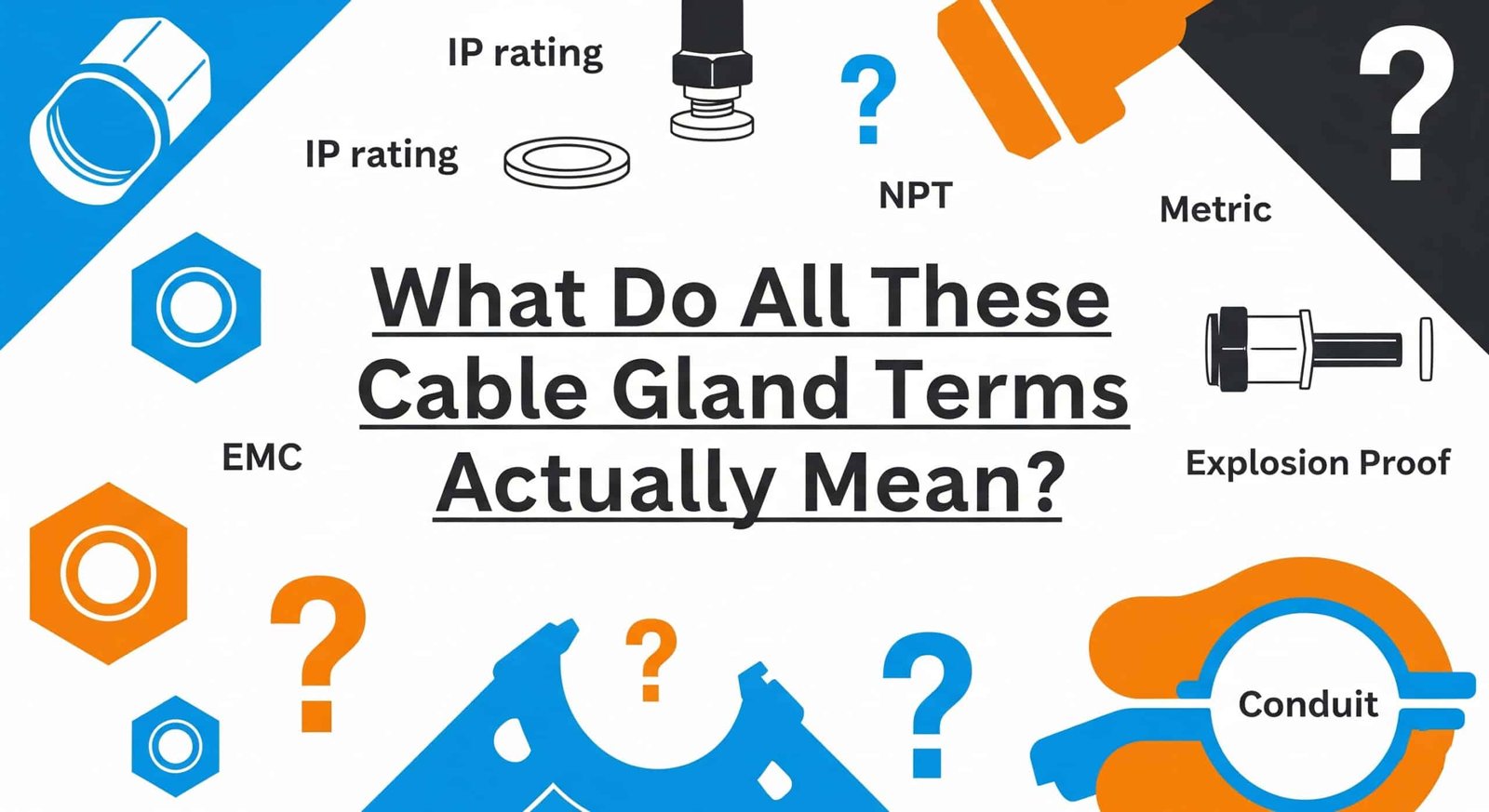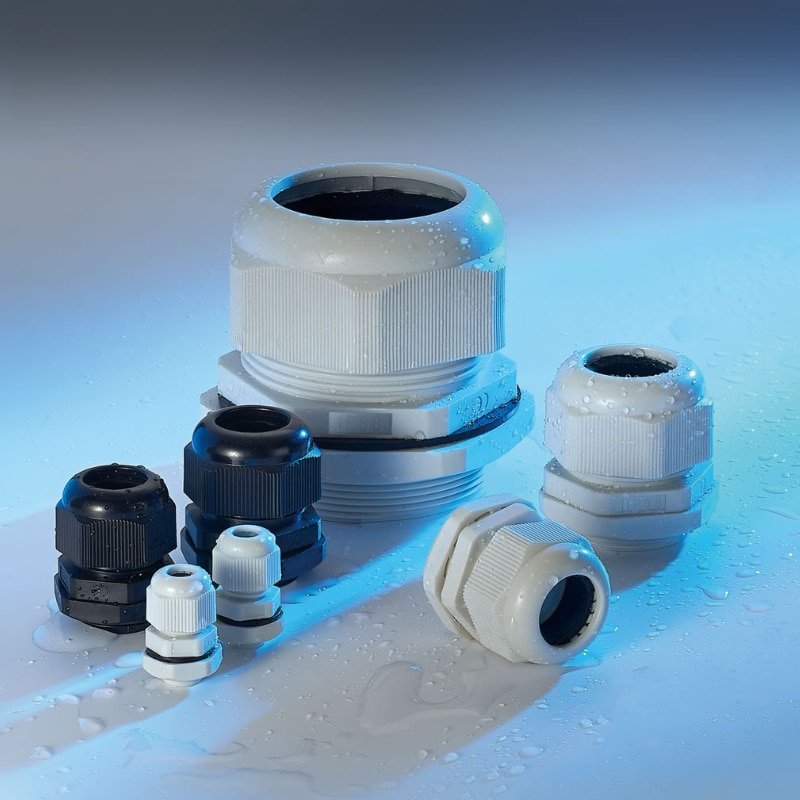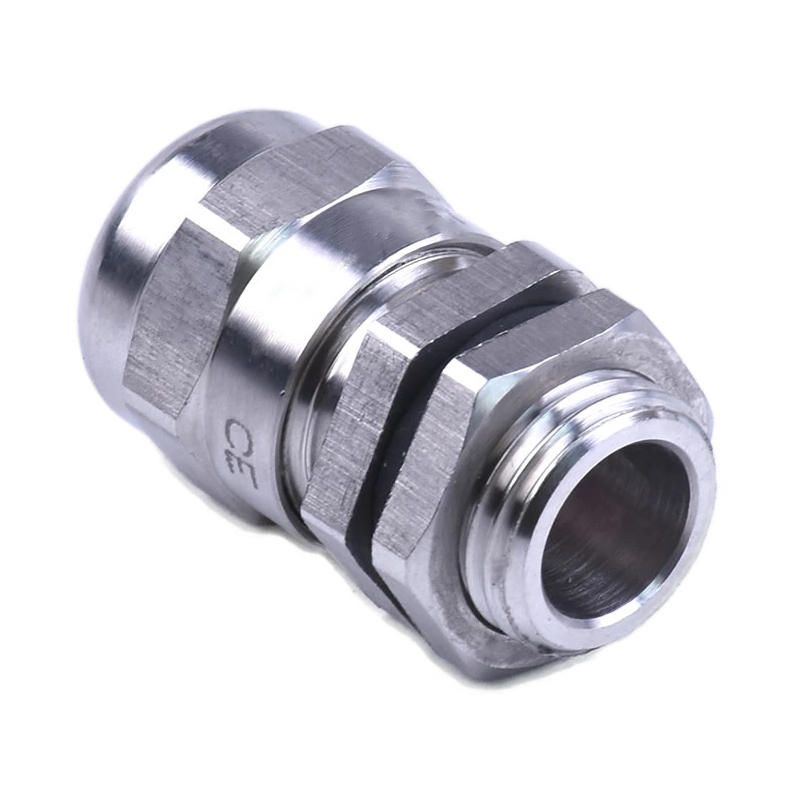Technical specifications, installation manuals, and supplier catalogs overwhelm engineers and procurement professionals with confusing cable gland terminology that seems designed to obscure rather than clarify, leading to costly specification errors, installation mistakes, and compatibility issues when the wrong products arrive on-site. Industry jargon like “stuffing glands,” “cable entries,” “strain relief,” and “IP ratings” creates communication barriers between suppliers and customers, resulting in project delays and frustrated teams who can’t decode what they actually need.
Terminologin för kabelförskruvningar omfattar standardiserade tekniska definitioner för tätningssystem, gängspecifikationer, materialklassificeringar och prestandaklassificeringar som möjliggör exakt kommunikation mellan ingenjörer, leverantörer och installatörer samtidigt som de säkerställer korrekt produktval och efterlevnad av regelverk. Understanding these terms is essential for anyone specifying, purchasing, or installing cable management systems in industrial, commercial, or marine applications.
Having worked with engineers, contractors, and procurement teams across Europe, North America, and Asia—from automotive plants in Munich to offshore platforms in the Gulf of Mexico—I’ve seen how terminology confusion creates real business problems. Let me decode the essential cable gland vocabulary every professional needs to communicate effectively and make informed decisions.
Innehållsförteckning
- What Are the Basic Cable Gland Component Terms?
- How Do Thread and Size Specifications Work?
- What Do IP Ratings and Performance Terms Mean?
- Which Material and Construction Terms Should You Know?
- What Are the Key Application and Industry Terms?
- FAQs About Cable Gland Terminology
What Are the Basic Cable Gland Component Terms?
Cable gland component terminology defines the essential parts including the body, sealing insert, compression nut, and strain relief elements that work together to provide cable entry, environmental sealing, and mechanical protection in electrical installations.
Understanding component terminology is crucial because each part serves specific functions that affect overall system performance and installation requirements.
Primary Component Definitions
Cable Gland Body: The main threaded component that mounts to equipment panels or enclosures, providing the primary structural connection and housing for sealing elements.
Compression Nut (Lock Nut): The threaded component that compresses sealing elements against the cable and creates the environmental seal when tightened to specified torque values.
Sealing Insert (Cable Seal): The elastomeric component that forms the primary environmental seal around the cable outer diameter, typically made from rubber, silicone, or specialized polymers.
Avlastning: The mechanical system that prevents cable tension from being transmitted to electrical connections, protecting both cables and terminations from damage.
Advanced Component Terms
Armor Clamp: Specialized component for terminating armored cables, providing mechanical connection to the cable’s metallic armor for grounding and strain relief.
Earth Tag (Grounding Lug): Metallic component that provides electrical connection between cable armor or shield and the equipment enclosure for safety grounding.
Reducer (Bushing): Insert component that adapts larger cable glands to accommodate smaller cable diameters while maintaining sealing effectiveness.
Blanking Plug: Solid insert used to seal unused cable gland openings, maintaining enclosure IP ratings when cables are not installed.
Sealing System Components
Primary Seal: The main sealing element that prevents environmental ingress around the cable entry point, typically an elastomeric insert or compression seal.
Secondary Seal: Additional sealing element that provides backup protection or enhanced sealing performance for demanding applications or higher IP ratings.
Thread Seal: Sealing system between threaded components, often using O-rings, gaskets, or thread sealant compounds to prevent ingress through thread interfaces.
Intumescent Seal: Fire-resistant sealing element that expands when exposed to heat, maintaining fire barriers and preventing flame propagation through cable entries.
I remember working with Jennifer, a project engineer at a major automotive plant in Detroit, Michigan. During a facility expansion, her team was confused by supplier quotations that mixed different terminology for the same components—some called them “cable glands” while others used “cord grips” or “strain reliefs.” The terminology confusion led to specification errors and delivery of incompatible products. After providing a comprehensive terminology guide and standardizing component definitions across all project documentation, her team successfully completed the installation on schedule with proper component compatibility. 😊
Installation and Mounting Terms
Panelens tjocklek: The mounting surface thickness that determines required thread engagement length for proper cable gland installation and sealing.
Tråd Engagemang: The number of threads that must be engaged between components to ensure adequate mechanical strength and sealing performance.
Mounting Hole: The precisely sized opening in equipment panels or enclosures that accommodates the cable gland body and provides proper fit.
Flange Mount: Alternative mounting method using a flanged base instead of threaded connection, often used for thin panels or specialized applications.
How Do Thread and Size Specifications Work?
Thread and size specifications use standardized systems including metric (M12, M16, M20), NPT1 (1/2″, 3/4″, 1″), and PG (PG7, PG9, PG11) designations that define mounting compatibility, cable diameter ranges, and mechanical dimensions for proper installation and sealing.
Understanding sizing systems is essential because incorrect specifications lead to compatibility problems and installation failures that can be costly to correct.
Metric Thread System (ISO)
M12 x 1.5: Metric thread designation where “M12” indicates 12mm nominal diameter and “1.5” specifies 1.5mm thread pitch, commonly used for small cable applications.
M16 x 1.5: Standard size for medium cables (6-10mm diameter), widely used in industrial control and instrumentation applications.
M20 x 1.5: Popular size for power cables (10-14mm diameter), common in motor connections and industrial power distribution.
M25 x 1.5: Larger size for heavy-duty applications (16-20mm cables), used in high-power industrial and marine installations.
NPT Thread System (North American)
NPT 1/2″: National Pipe Thread 1/2 inch designation, tapered thread system commonly used in North American electrical installations.
NPT 3/4″: Standard size for medium-duty applications, equivalent to approximately M20 metric threading for cable diameter compatibility.
NPT 1″: Larger size for heavy-duty cables and conduit connections, popular in industrial and hazardous area applications.
Thread Taper: NPT threads have a 1:16 taper that creates sealing through thread deformation, different from parallel metric threads that require separate sealing elements.
PG Thread System (German Standard)
PG7: Panzer-Gewinde (armor thread) size 7, designed for 3-6.5mm cable diameter range, commonly used in European control applications.
PG9: Standard size for small to medium cables (4-8mm), popular in automation and instrumentation systems.
PG11: Medium size for 5-10mm cables, widely used in European industrial electrical installations.
PG Thread Characteristics: Parallel threads with 30-degree thread angle, designed specifically for electrical applications with integrated sealing systems.
Cable Diameter Specifications
| Gänga Storlek | Område för kabeldiameter | Typiska tillämpningar | Regional Preference |
|---|---|---|---|
| M12 x 1,5 | 3-6,5 mm | Sensors, small control | Globalt |
| M16 x 1,5 | 4-8mm | Styrkablar | Globalt |
| M20 x 1,5 | 6-12 mm | Power, control | Globalt |
| NPT 1/2″ | 6-12 mm | General purpose | Nordamerika |
| PG9 | 4-8mm | Styrsystem | Europa |
Cable Range Tolerance: Most cable glands accommodate a range of cable diameters within their specification, providing flexibility for different cable types and applications.
Oversizing Considerations: Using cable glands significantly larger than cable diameter can compromise sealing effectiveness and strain relief performance.
What Do IP Ratings and Performance Terms Mean?
IP-klassning2 define Ingress Protection levels using a two-digit system where the first digit (0-6) indicates solid particle protection and the second digit (0-8) specifies liquid ingress protection, with common ratings like IP54, IP65, and IP68 indicating different environmental sealing capabilities.
Understanding IP ratings is critical because they determine where cable glands can be safely used and what environmental conditions they can withstand.
IP Rating Digit Definitions
First Digit (Solid Protection):
- IP0X: No protection against solid objects
- IP1X: Protection against objects larger than 50mm
- IP2X: Protection against objects larger than 12.5mm
- IP3X: Protection against objects larger than 2.5mm
- IP4X: Protection against objects larger than 1mm
- IP5X: Dust protected (limited ingress permitted)
- IP6X: Dust tight (no dust ingress)
Second Digit (Liquid Protection):
- IPX0: No protection against liquids
- IPX1: Protection against vertically falling drops
- IPX4: Protection against water splashing from any direction
- IPX5: Protection against water jets from any direction
- IPX6: Protection against powerful water jets
- IPX7: Protection against temporary immersion
- IPX8: Protection against continuous immersion
Common IP Rating Applications
IP54: Basic protection suitable for indoor applications with minimal dust and splash exposure, commonly used in control panels and dry locations.
IP65: Dust-tight and jet-proof protection for outdoor applications, washdown areas, and most industrial environments with good environmental sealing.
IP66: Enhanced jet protection for high-pressure washdown applications, food processing, and chemical plants requiring superior liquid protection.
IP67: Temporary immersion protection for applications that may experience flooding or temporary submersion up to 1 meter depth.
IP68: Continuous immersion protection for marine applications, underground installations, and permanent submersion conditions.
Performance and Testing Terms
Ingress Protection Test: Standardized testing procedures defined by IEC 60529 that verify cable gland sealing performance under specified conditions.
Tryckklassning: Maximum pressure differential that cable glands can withstand while maintaining sealing integrity, important for pressurized applications.
Temperaturklassning: Operating temperature range specification that defines safe operating limits for cable gland materials and sealing elements.
UV-beständighet: Material property that indicates resistance to ultraviolet radiation degradation, important for outdoor and solar applications.
Marcus, who manages maintenance for a large chemical processing facility in Rotterdam, Netherlands, learned the importance of IP rating terminology during a plant upgrade. His team initially specified IP54 cable glands for outdoor pump motor connections, not realizing these provided inadequate protection for their high-pressure washdown procedures. After understanding that IP65 was the minimum requirement for their jet-washing maintenance procedures, they upgraded to IP66-rated stainless steel cable glands that successfully withstand their aggressive cleaning protocols without compromising electrical safety.
Which Material and Construction Terms Should You Know?
Cable gland materials include nylon (polyamide), brass, stainless steel, and specialized alloys with specific properties for corrosion resistance, temperature performance, and chemical compatibility, while construction terms define manufacturing methods and quality standards.
Material terminology is essential because different applications require specific material properties for safety, durability, and regulatory compliance.
Primary Material Classifications
Nylon (Polyamide PA6/PA66): Lightweight, cost-effective polymer material offering good chemical resistance and electrical insulation properties for general-purpose applications.
Brass (CW617N/CW614N): Copper-zinc alloy providing excellent corrosion resistance, electrical conductivity, and mechanical strength for marine and industrial applications.
Stainless Steel (316L/304): High-grade steel alloy offering superior corrosion resistance, temperature performance, and mechanical strength for harsh chemical and marine environments.
Förnicklad mässing: Brass base material with nickel coating for enhanced corrosion protection and improved appearance in demanding applications.
Specialized Material Terms
ATEX Approved Materials: Materials certified for use in explosive atmospheres, meeting specific requirements for static electricity prevention and spark resistance.
Marine Grade Materials: Materials specifically designed for saltwater exposure, meeting maritime industry standards for corrosion resistance and longevity.
Food Grade Materials: Materials approved for food processing applications, meeting FDA or EU food contact regulations for safety and hygiene.
Chemical Resistant Materials: Specialized polymers or alloys designed to withstand exposure to specific chemicals, acids, or solvents without degradation.
Construction and Quality Terms
CNC Machined: Precision manufacturing using computer-controlled machining for tight tolerances and consistent quality in metal cable glands.
Injection Molded: Manufacturing process for polymer cable glands using high-pressure injection of molten material into precision molds.
Thread Forming: Manufacturing process that creates threads through material deformation rather than cutting, providing stronger thread engagement.
Ytbehandling: Finishing processes including anodizing, plating, or coating that enhance corrosion resistance and appearance.
What Are the Key Application and Industry Terms?
Application terminology includes hazardous area classifications (Zone 0, 1, 2), industry standards (ATEX, IECEx, UL), and specialized requirements for marine, railway, and renewable energy installations that determine appropriate cable gland selection and certification requirements.
Industry-specific terms are crucial because different sectors have unique safety requirements and regulatory standards that affect product selection and compliance.
Hazardous Area Classifications
ATEX Directive: European regulation for equipment used in explosive atmospheres, requiring specific certifications and design standards for cable glands.
Zone 0/1/2: Gas atmosphere classifications indicating different levels of explosive gas presence and corresponding equipment requirements.
Class I/II/III: North American hazardous area classifications for different types of hazardous materials including gases, dusts, and fibers.
Explosion-Proof: Equipment design that contains internal explosions without igniting external explosive atmospheres, requiring specialized cable gland designs.
Industry-Specific Applications
Marina tillämpningar: Saltwater-resistant installations requiring specialized materials and enhanced sealing for shipboard and offshore use.
Järnvägsstandarder: Transportation industry requirements including fire resistance, vibration resistance, and specific material certifications.
Solar Installations: Renewable energy applications requiring UV resistance, temperature cycling performance, and long-term outdoor durability.
Livsmedelsbearbetning: Hygienic applications requiring washdown resistance, FDA-approved materials, and easy cleaning designs.
Slutsats
Understanding cable gland terminology is essential for effective communication, proper product selection, and successful installations across all industries. This comprehensive glossary provides the foundation for making informed decisions and avoiding costly specification errors that can impact project success.
The key to mastering cable gland terminology lies in understanding how different terms relate to real-world applications and performance requirements. At Bepto, we provide not just products but also the technical knowledge and support to help customers navigate complex terminology and select the right solutions for their specific needs. Our team understands that clear communication and proper terminology use are essential for project success and customer satisfaction.
FAQs About Cable Gland Terminology
Q: What’s the difference between cable glands and cord grips?
A: Cable glands and cord grips are essentially the same product with different regional terminology. “Cable gland” is more common in Europe and international markets, while “cord grip” is often used in North America for the same cable entry and sealing function.
Q: How do I convert between metric and NPT thread sizes?
A: There’s no direct conversion between metric and NPT threads since they use different systems. M20 x 1.5 is approximately equivalent to NPT 3/4″ for cable diameter compatibility, but you need thread adapters for actual mechanical compatibility.
Q: What does “stuffing gland” mean in cable terminology?
A: Stuffing gland is an older term for cable glands, originating from marine applications where rope or cable entries were “stuffed” with sealing material. Modern cable glands use engineered sealing systems but the terminology persists in some industries.
Q: Are PG and metric threads interchangeable?
A: PG and metric threads are not interchangeable despite similar sizes. PG threads have different pitch and angle specifications, so you need the correct thread type for proper fit and sealing performance.
Q: What does EMC mean in cable gland specifications?
A: EMC stands for Electromagnetic Compatibility, referring to cable glands designed to provide electromagnetic interference (EMI) shielding. EMC cable glands include conductive materials and 360-degree shielding to prevent signal interference in sensitive electronic environments.







